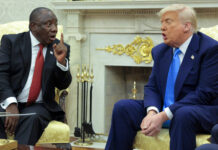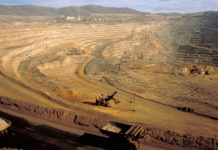
MINING executives are fond of claiming to follow value over volume strategies. In practice, they hardly ever do it. Why is this?
Mines, otherwise known as ‘holes in the ground’, are wasting assets carrying massive depreciation costs. Resource optimism is not just a job requirement, it’s axiomatic to the sector.
Gold Fields’s acquisition spree this year, announced deals totalling R70bn for Osisko Mining and Gold Road Resources, has added about 650,000 oz/year of gold to total group production – roughly a third of its current output.
Prior to this there were concerns Gold Fields was facing a ‘production cliff’ with output declining from 2.7 million to 2.1 million oz by some calculations from around 2027.
But Gold Fields CEO Mike Fraser estimates most of its production is longlife anyway, about 60% of output extends into the 2040s.
“I don’t think we’re facing a production cliff, but it requires work every day to find ways of replacing reserves, whether that’s greenfields exploration or Gruyere like we’ve done now,” he said earlier this month. Gruyere, a 350,000 oz per year mine was jointly owned by Gold Fields and Gold Road Resources.
“I know that we’ve got work to do to continue to change some of the perceptions around that,” he says of the view Gold Fields’s production is slipping.
AngloGold Ashanti is one of the world’s larger gold companies to have achieved production expansion. Its $2.5bn acquisition last year of Centamin, a UK-listed company operating the Sukari gold mine in Egypt, has proved a massive coup. AngloGold reported 230,000 oz more gold production in its first quarter results, largely owing to Sukari – a one-fifth year-on-year increase.
Gold shares still attractive?
It has taken shares in the company 65% higher year-to-date while Gold Fields is 43% higher. It’s worth pointing out more clearly than usual, however, that the gold space is a volatile one.
Shortly after the US and China agreed a more moderate tariff pact, gold shed $100/oz sending both Gold Fields and AngloGold into heavy one-day losses, down about 7.5% and 8% respectively.
Despite this, UBS analyst, Steve Friedman, remains bullish on the sector. Gold, he says, has formed a base at around $3,000/oz which supports his confidence in current ratings.
“Positive consensus earnings momentum should remain share price supportive in the near term, with multiple de-ratings unlikely and latest management guidance arguably more conservative, in our view, with updates only likely by 3Q25,” he said in a note this month.
“We believe the role of gold/gold equities as a diversifier in portfolios remains compelling,” he says.









